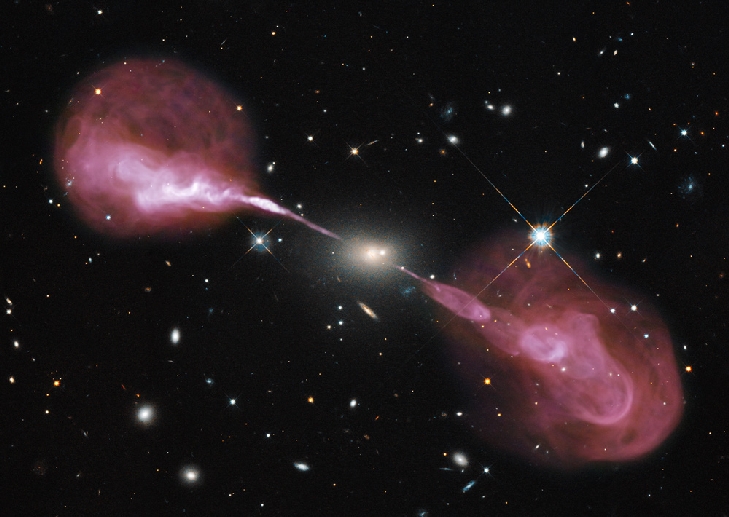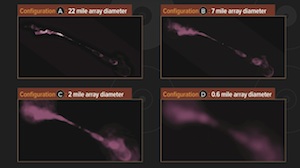November 29, 2012
Image Release: A Radio-Optical View of the Galaxy Hercules A

Credit: NASA, ESA, S. Baum and C. O'Dea (RIT), R. Perley and W. Cotton (NRAO/AUI/NSF), and the Hubble Heritage Team (STScI/AURA)
SPECTACULAR JETS powered by the gravitational energy of a supermassive black hole in the core of the elliptical galaxy Hercules A illustrate the combined imaging power of two of astronomy's cutting-edge tools, the Hubble Space Telescope's Wide Field Camera 3, and the recently upgraded Karl G. Jansky Very Large Array (VLA) radio telescope in west-central New Mexico.

(Click on image for larger version) Printable PDF Version (4.2 MB) |
Some two billion light-years away, the yellowish elliptical galaxy in the center of the image appears quite ordinary as seen by Hubble in visible wavelengths of light. The galaxy harbors a 2.5-billion-solar-mass central black hole that is 1,000 times more massive than the black hole in our Milky Way. But the innocuous-looking galaxy, also known as 3C 348, has long been known as the brightest radio-emitting object in the constellation Hercules. Emitting nearly a billion times more power in radio wavelengths than our Sun, the galaxy is one of the brightest extragalactic radio sources in the entire sky.
The VLA radio data reveal enormous, optically invisible jets that, at one-and-a-half million light-years long, dwarf the visible galaxy from which they emerge. The jets are very-high-energy plasma beams, subatomic particles and magnetic fields shot at nearly the speed of light from the vicinity of the black hole. The outer portions of both jets show unusual ring-like structures suggesting a history of multiple outbursts from the supermassive black hole at the center of the galaxy.
The innermost parts of the jets are not visible because of the extreme velocity of the material; relativistic effects confine all the light to a narrow cone aligned with the jets, so that light is not seen by us.
The entire radio source is surrounded by a very hot, X-ray-emitting cloud of gas, not seen in this optical-radio composite.
Hubble's view of the field also shows a companion elliptical galaxy very close to the center of the optical-radio source, which may be merging with the central galaxy. Several other elliptical and spiral galaxies that are visible in the Hubble data may be members of a cluster of galaxies. Hercules A is by far the brightest and most massive galaxy in the cluster.
The National Radio Astronomy Observatory is a facility of the National Science Foundation, operated under cooperative agreement by Associated Universities, Inc.
VIDEO: A Scientist Explains the Image
Additional Image Formats:
Large JPEG for printing
PDF for printing
High-Resolution TIFF (42.9 MB)
More Information and Image Formats:
Space Telescope Science Institute
Hubble Heritage
Contacts:
John Stoke
National Radio Astronomy Observatory, Charlottesville, VA
434-244-6896
jstoke@nrao.edu
Ray Villard
Space Telescope Science Institute, Baltimore, MD
410-338-4514
villard@stsci.edu
Dave Finley
National Radio Astronomy Observatory, Socorro, NM
(575) 835-7302
dfinley@nrao.edu
